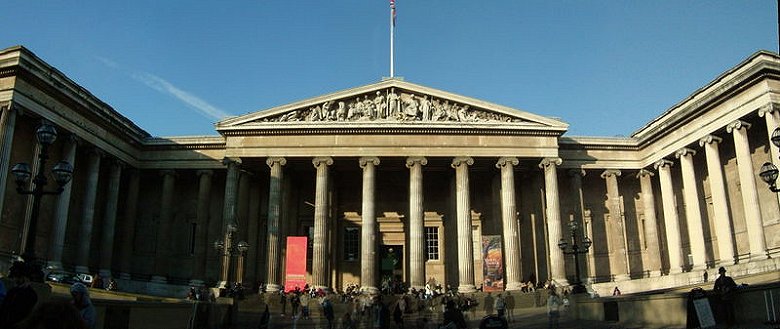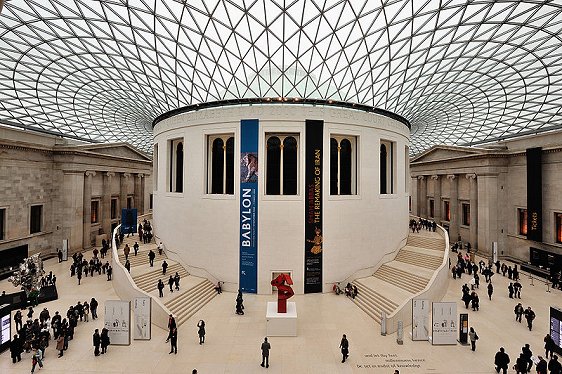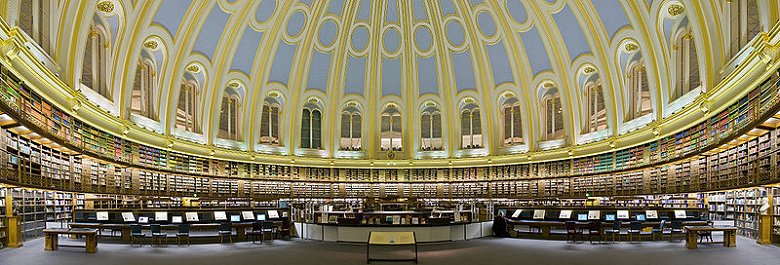
British Museum, London
 British Museum
British MuseumSource: https://commons.wikimedia.org/wiki/File:British_Museum.jpg
Author: Steff

The British Museum is one of the greatest museum in the world on human history and culture. It is located at Great Russell Street in Bloomsbury. Its collection of over 13 million objects is one of the largest and most comprehensive in the world. They come from all continents, illustrating and documenting the story of human culture from its beginning to the present.
The British Museum was founded in 1753, based on the collection of Sir Hans Sloane, a physician and scientist. It first opened to the public on 15 January 1759 in Montagu House, in Bloomsbury, where it still is, today. Its expansion resulted in the opening of branch institutions, including the British Museum (Natural History) in 1887 and the British Library spin off in 1997. As with all national museums and art galleries in Britain, the British Museum does not charge an admission fee except for charges levied for temporary special exhibitions.
Sir Hans Sloane had been an avid collector of curiosities. When he died in 1753, he bequethed his collection to King George II, for the princely sum of 20,000 pounds, so that it will not be broken up. Within his collection are 71,000 objects of all kinds, including 40,000 printed books, 7,000 manuscripts, 337 volumes of dried plants, prints, drawings, and antiquities from Egypt, Greece, Rome, the Ancient Near and Far East, and the Americas.
King George II gave his formal assent to establish the British Museum on 7 June 1753. Two other libraries were added to the Sloane collection. They are the Cottonian Library, assembled by Sir Robert Cotton and the Harleian Library, collected by the Earls of Oxford. The Royal Library, assembled by various British monarchs, were added in 1757. This comes from King George II. With it comes also the right to every book published in Great Britain, ensuring that the Museum's collection will grow indefinitely. Within these four "foundation collections" are some of the treasured books of the British Museum, now within its spin-off, the British Library. They include the Lindisfarne Gospels and the sole surviving copy of Beowulf.
 Great Court, British Museum
Great Court, British MuseumSource: https://commons.wikimedia.org/wiki/File:British_Museum_Dome.jpg
Author: Eric Pouhier

At the time of its creation, British Museum was a pioneer of sorts. Being a national institution, it belongs neither to the church or the king, and is freely open to the public with the aim of collecting everything. Sloane's collection, although encompassing a diversity of objects, tended to reflect his scientific interest. The Cotton and Harley manuscripts introduced a literary and antiquarian element to the collection, so that the British Museum is both a national museum and a national library.
To find a home for the British Museum, the Board of Trustees bought Montagu House, a 17-century mansion, from the Montagu family, for 20,000 pounds. They rejected Buckingham House (which today is Buckingham Palace) because it was too expensive. The first exhibition galleries and reading room for scholars opened on 15 January 1757. In 1772 the Museum acquired its first antiquities of significance, a collection of Greek vases from Sir William Hamilton. The Thomason Library and David Garrick's Library were added to its collection. At that time, the British Museum has not yet acquired the ancient relics that visitors see today.
The voyages of Captain James Cook resulted in a whole batch of South Sea objects added to the British Museum collection. By 1800, Montagu House was becoming very crowded and decrepit, and it was clear that space was running out. A significant milestone was achieved in the beginning of the 19th century (1800-1825), when the antiquities of Greece, Rome and Egypt were added to the British Museum. The Rosetta Stone - key to deciphering hieroglyphs - was added in 1802. The Colossal bust of Ramesses II came in 1818, laying the foundation for the Egyptian Monumental Sculpture collection. The marble sculptures of the Parthenon, on the Acropolis in Athens, were moved to Britain in 1806, and in 1816 were acquired by The British Museum by Act of Parliament.
In 1802, a Buildings Committee was set up to plan for the expansion of the British Museum. The old Montagu House was demolished in 1823. Sir Robert Smirke designed a grand neoclassical building for it. Part by part was completed, with the King's Library on the East Wind ready in 1827, but was only opened to the public in 1857. By then, the collection was growing faster than the building can be expanded. In 1852, the forecourt was opened, in accordance to Robert Smirke's 1923 design. Sydney Smirke's Round Reading Room, with space for one million books, was opened in 1857. Because the British Museum was still pressed for space, the natural history section was moved to a new building in South Kensington, and it became known later as the British Museum (Natural History), now the Natural History Museum. 1884 saw the completion of the White Wing, allowing space for more antiquities and ethnography.
By the last years of the 19th century, The British Museum has once again outgrown the space. The Trustees in 1895 purchased 69 houses surrounding the Museum, with the intention of demolishing them and building the West, North and East sides to the Museum. The first phase of construction of the north wing began in 1906.
In 1918, due to threat of wartime bombing, some of the objects were stored away at the Portal Tube Railway at Holborn, at the National Library of Wales, and at a country house near Malvern. Some of these objects were damaged in transition, necessitating the creation of a conservation laboratory to restore them. This took place in 1920, and became a permanent department in 1931.
In August 1939, with the Second World War looming, the most valuable and portable objects were evacuated. No wonder, for the museum was bombed in 1941. The years following was spent rebuilding the damaged building and returning the stored items.
The British Museum celebrated its bicentennial in 1953. In 1963 the Natural History Museum became a fully independent entity. The Coins and Medals collection, damaged during the war, reopened in 1959. Following that, the Parthenon Sculptures were back on display in 1962, with the restoration of the Duveen Gallery.
1972 saw 1,694,117 visitors coming to see the "Treasures of Tutankhamun", the most successful exhibition in the British Museum history. That same year saw another Act of Parliament separating the British Library's collection of manuscripts and printed books from the Britsh Museum. The growing books collection required a new home, but that was not to happen until another 25 years have passed, when the British Library moves to its new home at St Pancras.
The departure of the British Library fees up the vacant space in the 19th century central quadrangle. It was redeveloped into the Queen Elizabeth II Great Court - the largest covered square in Europe, opened in 2000.
The British Museum was set up 250 years ago as an encyclopedia of nature and of art. Today, it no longer houses collections of natural history. Even the books and manuscripts that were its foundation collection now belongs to the independent British Library. Nevertheless the British Museum maintains its universality in its collection of artefacts representing the cultures of the world.
How to get there
Address: Great Russell Street, London WC1B 3DGPhone: 020 7323 8299
Opening Hours: 10:00am - 5:30pm daily, Thurs & Fri till 8:30pm
Admission Fee: Free
Nearest Tube Stations: Holborn Station, Tottenham Court Road Station, Russell Square Tube Station, Coodge Street Tube Station
Buses: No. 7, 38, 10, 91 and 188
What to see
What to see? Hmm, I am not sure I can finish describing everything. Okay, the exhibits are spread out into three levels, from bottom to top they are the Lower Floors, the Ground Floor and the Upper Floor. On the Lower Floors, we find Africa exhibitsn in Room 25, Greece and Rome (Room 77-85), Ancient Near East (Room 88-89). On the Ground Floor, Temporary Exhibits occupy Rooms 1-2, 5, 24 and 35; Egyptian exhibits (Room 4), Ancient Near East (Room 6-10), Greece (Room 11-23) and The Americas (Rooms 26-27). On the Upper Floor, we see Temporary Exhibits on Room 36, Prehistory (Rooms 37, 50), Europe (Rooms 41-48), Roman Britain (Room 49), Ancient Near East (Rooms 51-59), Egypt (Room 60-66), Asia (Rooms 67, 91-94), Money and Medals (Rooms 68 & 69a), Greece and Rome (69-73) and finally Prints and Drawings (Room 90). I know all this information will not quickly register or make sense, so just pay a visit to the museum and you will have a wonderful time discovering all the exhibits at your own pace. Reading Room, British Museum
Reading Room, British MuseumSource: https://commons.wikimedia.org/wiki/File:British_Museum_Reading_Room_Panorama_Feb_2006.jpg
Author: Diliff

 The King's Library, British Museum
The King's Library, British Museum